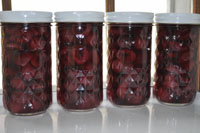Posted by · Leave a Comment
Slipping Tomato Skins
Many cooked tomato canning recipes call for tomatoes to be “washed, cored, peeled and chopped” (in fact, I can’t think of one right off the bat that doesn’t). The simplest way to peel a tomato is just to “slip the skin.”
Here are the simple steps:
- Wash, core and inspect your tomatoes (remove any bad spots)

- Place the tomatoes gently into boiling water for 30-60 seconds. You’ll notice the skin start to “crack”
- Immediately transfer tomatoes to cold water (I add a little ice as well—to keep the cold water from warming too quickly)
- Using your hands, gently peel or “slip” the skin off.
The green tomato in the batch is an heirloom variety and RIPE!  I needed it to fill out the weight of the tomatoes required in my barbeque sauce recipe. No one will ever know; shhhhh! Don’t tell…
I needed it to fill out the weight of the tomatoes required in my barbeque sauce recipe. No one will ever know; shhhhh! Don’t tell…

 When you can fruits or veggies, you hope for the best…the best quality, the best “seal,” the best (and prettiest) presentation or “pack.”
When you can fruits or veggies, you hope for the best…the best quality, the best “seal,” the best (and prettiest) presentation or “pack.” Sometimes, everything comes together on the very first go-round – like the Ball recipe for Spirited Cherries I attempted for the first time yesterday.
Sometimes, everything comes together on the very first go-round – like the Ball recipe for Spirited Cherries I attempted for the first time yesterday. So very delicious…and simple…and pretty…that I just had to do a second batch immediately! These will be a perfect addition to a main course or dessert, especially in the winter when you seek out those bolder flavors.
So very delicious…and simple…and pretty…that I just had to do a second batch immediately! These will be a perfect addition to a main course or dessert, especially in the winter when you seek out those bolder flavors. The Navajo-Churro wool is beautiful! Just look at the colors of the sheep I was able to photograph before everyone came charging into the barn last week. I’ve been fascinated by their coats since we first purchased Reese and her twins, Lovey and Clara (Clara Barton Angel Of The Battlefield, so named by my history-loving son) years ago.
The Navajo-Churro wool is beautiful! Just look at the colors of the sheep I was able to photograph before everyone came charging into the barn last week. I’ve been fascinated by their coats since we first purchased Reese and her twins, Lovey and Clara (Clara Barton Angel Of The Battlefield, so named by my history-loving son) years ago. Every morning, a local dairy farmer leads his herd down the road to another pasture and then collects them in the evening to milk. If you time it just right, you get to watch the march—it’s special—only this time, it caught the school bus. I bet if Bob has to call the transportation office to explain the tardiness, not much of an excuse is needed.
Every morning, a local dairy farmer leads his herd down the road to another pasture and then collects them in the evening to milk. If you time it just right, you get to watch the march—it’s special—only this time, it caught the school bus. I bet if Bob has to call the transportation office to explain the tardiness, not much of an excuse is needed.  I wander around the yard and barn capturing images I think would make nice accompaniments to blog entries and snapped this one of the chair in my flower bed.
I wander around the yard and barn capturing images I think would make nice accompaniments to blog entries and snapped this one of the chair in my flower bed.  I used to bring mom big handfuls of Queen Anne’s lace which she displayed proudly despite her terrible pollen allergy.
I used to bring mom big handfuls of Queen Anne’s lace which she displayed proudly despite her terrible pollen allergy.
 This very brown pile is responsible for making our corn very happy.
This very brown pile is responsible for making our corn very happy. 

